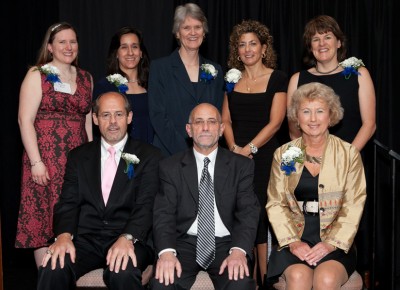Mary Broderick has always gravitated toward education. As an English major undergraduate, she had just completed her MBA when she first moved to East Lyme, CT. At the time, her children were very young and she started attending board of education meetings for the East Lyme school system, which had 2,600 students (it’s now up to 3,300 students). She quickly got hooked: that was 1989 and she hasn’t looked back since.
She first began with writing reports of the board meetings, which were used for the PTA newsletters. Board elections were coming up and board members approached her about running for a position. Broderick was successful in getting elected and her MBA, from the University of Toronto, prepared her for effective school board governance, since she understood finance and budgets, community engagement and marketing, and motivating staff. She became very involved with the East Lyme school board, serving as board chairperson for two terms and a myriad of committee chair roles, when the Connecticut Association of Boards of Education (CABE) came calling in the early 1990s. During that time, she also worked closely with the Connecticut Department of Education on issues ranging from preschool education to teacher recruitment and mental health issues.
Her leadership skills and education knowledge proved beneficial while serving on the CABE’s board of directors. She then progressed to a two-year term as president of CABE in 2002. Broderick’s passion and enthusiasm for education and advocacy on behalf of public school children grew and she felt compelled to serve at the national level and she was elected to serve on the National School Boards Association (NSBA) board of directors in 2005. NSBA leaders saw her potential too, and recently elected her president of the national organization for a one-year term. She had previously served as secretary-treasurer and president-elect.
“We are delighted to have Mary Broderick, who has such a long history of board leadership and advocacy on behalf of students in public education, as NSBA’s new president,” said Anne L. Bryant, Executive Director of NSBA. “Mary brings her ability to create an effective vision for public education and her skills at reaching those goals to the arena of local school governance.”
Broderick will draw on her experiences to hone in on traits that bolster environments for students to flourish and said those characteristics can be incorporated by school officials across the country.
“Student success must be the priority,” Broderick said. “I look forward, as NSBA president, to hearing from and working with educational leaders at all levels to encourage new investments in innovation to promote student learning.”
In her “spare” time, which is obviously quite spare, she recently completed a Ed.D. in Educational Leadership at UConn’s Neag School of Education. Broderick, now officially Dr. Broderick, focused her dissertation on the practices of superintendents in school districts outperforming demographically similar districts. She was able to integrate academic research with her 20+ years of school board leadership experience and advocacy, an ideal combination for her role as NSBA president.
The decision to pursue an Ed.D. was “actually someone else’s brilliant idea” recalled Broderick. “We had a dynamic superintendent (at East Lyme) who wanted to bring doctoral opportunities to a number of talented administrators and teachers in our region,” she said. “He first talked UConn into offering a cohort in our area, then he encouraged me and others to apply. He thought it would be interesting for me to get a credential for all the work I’d been doing in my then 16 years on the local board.”
Broderick selected the Neag School of Education’s program due to the School’s strong reputation and she had met some of the professors. “I thought I would be able to study some interesting topics. Plus, it was offering a local Ed.D. cohort, so it was feasible.”
Her Ed.D. has already helped her professionally. The speech she gave before the 5,000 NBSA annual conference attendees was closely tied to her dissertation work. She also continues to use many the concepts she studied at Neag in her columns and speeches.
“Thanks to my course work, I am well-informed about motivation and adult learning, which allows me to offer alternative perspectives to many current issues (like value-added compensation),” she continued.
In addition to her role of NBSA president, Broderick works with communities on efforts to improve odds of early school success as an educational consultant with the William Caspar Graustein Memorial Fund. She also supports communities across the state in conducting conversations about educational topics of their choosing. Broderick previously worked as a facilitator for the Community Coalition for Children and in higher education in financial aid and admissions at Wheelock College.
With 20+ years of school board leadership experience behind her, along with completing her Ed.D., Broderick has some sage advice for fellow education leaders. “Take the time to build a strong team, empowering school board members as well as staff,” offered Broderick. “When the district and community – especially through the board – are aligned behind a common vision, great learning can happen. CABE and NSBA offer tools to help boards and superintendents work together more effectively.”
Broderick thinks it’s important to avail oneself to those tools for the sake of the students. “School board governance is very important to ensure that communities own and support their schools.”
At the end of the day, it’s all about the students.
 Nigel Hayes, 9, of
Nigel Hayes, 9, of 
 Rather than react to bullying incidents in schools with heavily punitive policies, a systemic, preventive approach that avoids demonizing students and strengthens the overall climate in classrooms is the way to go,
Rather than react to bullying incidents in schools with heavily punitive policies, a systemic, preventive approach that avoids demonizing students and strengthens the overall climate in classrooms is the way to go,  In the last decade or more, the national debate about effective learning has centered on teacher quality. Now the discussion is turning to a second major resource in education: Time.
In the last decade or more, the national debate about effective learning has centered on teacher quality. Now the discussion is turning to a second major resource in education: Time. Accolades – below are news and notes from our alumni, faculty, staff, and students. We are proud of all the amazing accomplishments by our Neag family. If you have an accolade to share, we want to hear from you! Please send any news items (and story ideas) to
Accolades – below are news and notes from our alumni, faculty, staff, and students. We are proud of all the amazing accomplishments by our Neag family. If you have an accolade to share, we want to hear from you! Please send any news items (and story ideas) to 
